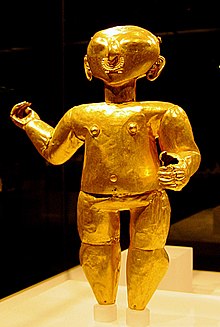 Map of the area occupied by Tumaco-La Tolita culture. | |
| Geographical range | Coast of Colombia and Ecuador |
|---|---|
| Period | Pre-Columbian era |
| Dates | 350 BC – 400 AD |
| Major sites | La Tolita, Isla del Morro, Inguapí |
| Preceded by | Chorrera culture |
| Followed by | Atacames culture |

The Tumaco-La Tolita culture or Tulato culture,[1] also known as the Tumaco Culture in Colombia or as the Tolita Culture in Ecuador[2] was an archaeological culture that inhabited the northern coast of Ecuador and the southern coast of Colombia during the Pre-Columbian era. It takes its name from the two most representative archaeological sites of the culture, the Isla del Morro in the city of Tumaco and the Isla de la Tolita. They are known for the construction of earthen mounds known as Tolas, ceramic crafts and especially metalworking, since they handled gold with great skill and were also the first artisans in the world to work with platinum.[3]
- ^ Patiño, Diógenes (2017). "Tumaco-Tolita: cultura, arte y poder en la costa pacífica". Antropología: Cuadernos de Investigación (in Spanish). 18 (18): 40–54. doi:10.26807/ant.v0i18.123. Retrieved 5 April 2023.
- ^ Morales Cabezas, Isaías (2013). Frassani, Alessia (ed.). Del Testimonio al Artificio en el Arte Aborigen: La Influencia de la Frontera en el Estudio de Tumaco-La Tolita (PDF). Universidad de los Andes: Facultad de Artes y Humanidades. Retrieved 2 August 2022.
- ^ Meeks, N.; La Niece, S.; Estévez, P. (2002). "The technology of early platinum plating: a gold mask of the La Tolita culture, Ecuador". Archaeometry. 44 (2): 273–284. doi:10.1111/1475-4754.t01-1-00059. Retrieved 5 April 2023.